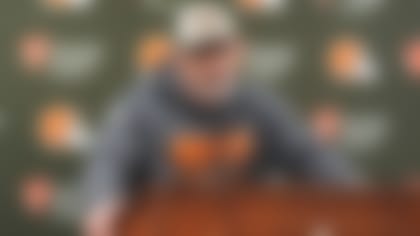The first wave of NFL free agency came and went almost before it even officially started last week, thanks to a head-spinning series of trades and a game of quarterback musical chairs that seemingly ended with AJ McCarron landing in Buffalo.
That was brief and memorable, but while the headlines and contracts are smaller, the second tier of free agency -- already well underway -- is at least as important. Who gets signed in this phase? The players who fill out rosters, provide depth and serve as critical cogs to complement the stars. They may not command wall-to-wall coverage, but the signings (or lack thereof) can tell us plenty about a team's intentions, now and in the draft.
Here are five situations that pose intriguing questions as more players switch teams and the league turns its attention to the 2018 NFL Draft in the coming weeks:
1) How do the New England Patriots fill the holes that opened?
The Patriots were busy late last week and into the weekend, trading for returner and possible deep threat Cordarrelle Patterson and signing Adrian Clayborn, Jeremy Hill and Matt Tobin. Still, the biggest hole from a mini-free agency exodus still looms -- who is going to replace left tackle Nate Solder, who decamped for the New York Giants? The Patriots agreed Thursday to re-sign LaAdrian Waddle to a one-year contract, but it's hard to see him or Tobin as long-term answers at the position. They haven't had this big a question at left tackle since Tom Brady became the starter in 2001. Matt Light started that year and the Patriots drafted Solder in the first round in 2011, with Light's career in its twilight. Solder played one season at right tackle until Light retired and then Solder slipped seamlessly over to the left side.
Bill Belichick and Patriots director of player personnel Nick Caserio have nearly six months to figure out the best way to handle the void on the left side, but it's an understatement to say the Patriots' move here is critical. Whomever they plunk down there this fall will be protecting the blind side of a very valuable 41-year-old quarterback.
2) What are the Miami Dolphins doing?
The Dolphins have positioned this as a necessary culture change after a 6-10 season, but the bottom line is they have shed a lot of top-level talent in the last two weeks. Gone are Jarvis Landry, Ndamukong Suh and Mike Pouncey. The Dolphins moved quickly on the offensive line, acquiring center Daniel Kilgore and signing guard Josh Sitton, and they added receivers Danny Amendola and Albert Wilson, as well as quarterback Brock Osweiler. The biggest addition, of course, will be the hoped-for return to health of quarterback Ryan Tannehill. But Suh and Landry -- and Pouncey, when healthy -- are dominant players at their respective positions and will not be easily replaced. The prism through which every Dolphins' decision -- every AFC East decision, really -- has to be viewed: Does this get you closer to overtaking the Patriots? It's hard to see that in South Florida right now.
3) For that matter, what is happening in Seattle?
The Seahawks always sit out the first wave of free agency and then find pieces at their price later on -- so deep breaths, Pacific Northwest. The list of departures this year is long and star-studded, though: Richard Sherman, Michael Bennett, Paul Richardson, Jimmy Graham, Sheldon Richardson. Plus, there are significant questions about whether Cliff Avril and Kam Chancellor will play again -- questions raised by Pete Carroll himself -- because of neck and spine injuries. This feels very much like the end of an era for the Seahawks, particularly with the Rams and 49ers, their division rivals, loading up to make runs with their young quarterbacks. Avril was a second-wave free agent when Seattle signed him, so the acquisitions of the next few weeks could be the stars of the next few seasons. But like the Dolphins, there is a lot of talent to replace. The big difference between the two franchises: The Seahawks have a superstar quarterback to smooth over even the bumpiest of transitions.
4) So, Jon Gruden wasn't kidding about bringing 1998 back?
The first few days of free agency saw Gruden reach back for some tried-and-true veterans, signing receiver Jordy Nelson and running back Doug Martin. Martin is 29, has averaged 2.19 yards per rushing attempt in the last two seasons and will apparently be paired with the 30-plus Marshawn Lynch. Nelson will be 33 in May and is coming off a season in which his production dropped dramatically, in part because Aaron Rodgers got hurt. His arrival caused the Raiders to release the younger Michael Crabtree. Gruden often stuck with veterans at his previous stops in Oakland and Tampa Bay -- he values experience and proven production -- but much of the rest of the NFL has tilted toward youth. Check the birthdates of everybody who signs from now on.
5) Safeties, anybody?
Tyrann Mathieu and Morgan Burnettfinally signedat the start of the week, but one of the oddities of the beginning of free agency was the almost complete lack of movement for safeties. Weird, considering the increasing importance of the position in the three-wide-receiver era. Kenny Vaccaro and Eric Reid are among the big-name versatile safeties who are still waiting for the market to shake out. Mathieu's one-year deal for $7 million is far below what was expected to be the going rate, an indication that part of what slowed the market was that teams thought the safeties had over-inflated contract expectations and were willing to wait them out. It appears to have worked.
Follow Judy Battista on Twitter @judybattista.












